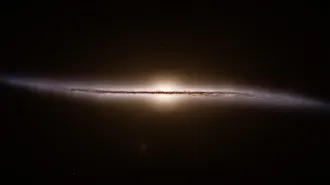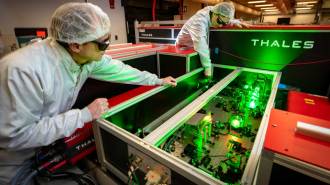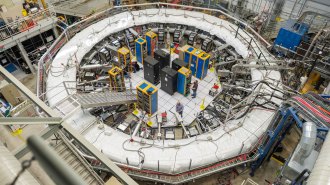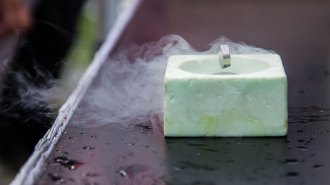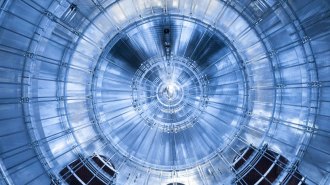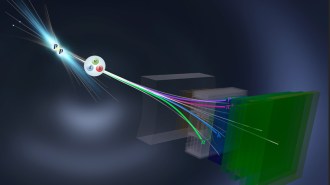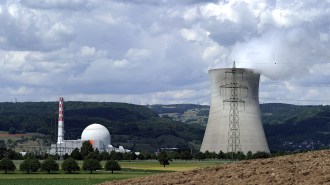This laser would shoot beams of neutrinos, not light
A proposed technique could form a coherent beam from the reclusive subatomic particles

A laser beam of neutrinos (illustrated) could be created in a laboratory, scientists propose. The Greek letter ν is the symbol for a neutrino.
Jose-Luis Olivares/MIT, iStock
Neutrino lasers: It’s an idea that many physicists didn’t see coming.
At first glance, physics suggests that it would be impossible to make a laser of neutrinos, famously elusive subatomic particles. But an unconventional trick raises the possibility.
A quantum mechanical phenomenon called superradiance underpins the idea. In superradiance, a group of atoms is coaxed to collectively emit light in a burst, rather than in dribs and drabs. Under the right conditions, superradiance could produce a neutrino burst instead, physicists report in the Sept. 12 Physical Review Letters. Such beams could enable new studies of neutrinos and quantum physics.
“It’s so rare to see such new, out of the box thoughts and ideas,” says neutrino physicist Carlos Argüelles of Harvard University. “This is just super cool.”
Traditional lasers are based on the idea of stimulated emission, in which one particle of light encourages more light to be emitted. (The word “laser” is actually an acronym referencing this process: Light Amplification by Stimulated Emission of Radiation.) But stimulated emission applies only to particles of light and other particles in the same category, known as bosons. Neutrinos, which are a different class of particle called fermions, don’t fit that bill.
Enter superradiance, a nontraditional method for creating lasers. The effect produces a burst of light or particles all emitted in the same direction with the same energy, as in a standard laser beam. And superradiance applies not only to bosons, but also to fermions, including neutrinos. And that, says Benjamin Jones, a physicist at the University of Texas at Arlington, “doesn’t appear to have been widely recognized before.”
He and physicist Joseph Formaggio of MIT unearthed that neglected gem and ran with it. The pair came up with a scheme to harness superradiance to produce neutrinos, which they hope can soon be demonstrated in a laboratory.
The technique requires a Bose-Einstein condensate, a state of matter in which atoms are cooled enough that they take on the same quantum state. But there’s a twist: The Bose-Einstein condensate must be radioactive. Jones and Formaggio propose using a radioactive variety of the element rubidium, rubidium-83, which produces a neutrino when it decays.
Normally, rubidium-83 decays with a half-life of about 86 days. But for rubidium-83 in a Bose-Einstein condensate, that decay would be dramatically sped up. A million rubidium-83 atoms would decay with a half-life of minutes, producing a neutrino surge. For larger numbers of atoms, the speedup would be even greater.
Superradiance stems from the quantum mechanical concept of superposition, in which particles exist in two states at once. If a radioactive decay occurs in a group of identical atoms — such as a Bose-Einstein condensate — it can be impossible to know which one decayed. This creates a superposition in which atoms have both decayed and not decayed. And once multiple decays have occurred, there will be many possible orders in which the various atoms could have decayed — it’s impossible to tell which atom decayed first, which went second and so on. It’s a situation that ramps up the rate of radioactive decay and neutrino emissions.
Creating a neutrino laser would be challenging, says nuclear physicist Kyle Leach of Colorado School of Mines in Golden. But “there’s no showstopping conceptual reason why this shouldn’t work, at least not in my mind. And if it does succeed, the payoffs are huge.” If physicists get their hands on neutrino lasers, Leach says, “you can really start thinking about doing a wide range of new physics experiments that you otherwise couldn’t do.”
The technique could help free neutrino physicists from their dependence on costly particle accelerator facilities, where neutrino beams are currently produced. Although neutrino lasers couldn’t match the energies or intensities of accelerator beams, lasers would have something accelerator beams don’t. In a neutrino laser, the particles would be correlated: “Somehow they are holding hands in a quantum mechanical way,” Argüelles says.
That feature could help physicists study the collective behavior of quantum particles, such as when an aging star collapses and explodes in a supernova. There, vast quantities of neutrinos are produced at once. The resulting neutrino scrum behaves collectively in a way that’s not well understood. Neutrino lasers could help. And in the far future, Leach imagines shooting two neutrino lasers at one another to see how they would interfere.
But first, the researchers need to show that their idea is real. “This is an experiment that can be done and can be done in a tabletop-scale experiment in a university lab,” Jones says. “So we should find out if this process really happens like we say it does.”
